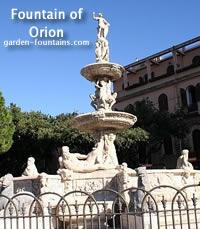The drawing of the Tigris Wall Fountains shows the natural setting Michelangelo designed for this special fountain. According to Vasari, the niche of this fountain was created in the vision of a rocky cave, paleish green in color. This paleish green color is stratified marble known as “cippollaccio”. Water trickles down the rocky bed in an irregular fashion, not like the formal, single jet fountains into the sarcophagus below just before overflowing install a small, fluted shell shaped basin at the base of the wall fountain . Water then overflows the sarcophagus, out of which appears to be two crawling life-like looking turtles. These turtles serve as the support features at the corners of the sarcophagus. In Florence, the reclining river God was a popular subject for decoration on the recessed areas of single niche wall fountains.
 Ancient garden statuary were absent from Rome, causing sculptors to carve their very own figures in the likeness of classical style and poses of Roman examples. Attributes were added to these garden statues to convey the attitude and style of the local area. Examples recorded at Florence were modeled after the colossal temporary fountains that were created by Montorsoli, Tribolo, and Raffaello da Monteulpo. These fountains were created for the fifth visit of Charles to Florence. These fountains represented the local Arno, Rhine, Danube, Bagradas, and Hiberus rivers. The Rhine, Danube, Bagradas, and Hiberus rivers were depicted to symbolize emperor Charles’s far reaching dominions. The positions and attributes of these fountains follow ancient types, as stated in Vasari’s description, but he does not discuss the settings of the fountains. As fate would have it, we do have more information regarding the twin wall fountains, Arno and Mugnone, which were created by Tribolo in the Villa of Castello between the years 1538 and 1547.
Ancient garden statuary were absent from Rome, causing sculptors to carve their very own figures in the likeness of classical style and poses of Roman examples. Attributes were added to these garden statues to convey the attitude and style of the local area. Examples recorded at Florence were modeled after the colossal temporary fountains that were created by Montorsoli, Tribolo, and Raffaello da Monteulpo. These fountains were created for the fifth visit of Charles to Florence. These fountains represented the local Arno, Rhine, Danube, Bagradas, and Hiberus rivers. The Rhine, Danube, Bagradas, and Hiberus rivers were depicted to symbolize emperor Charles’s far reaching dominions. The positions and attributes of these fountains follow ancient types, as stated in Vasari’s description, but he does not discuss the settings of the fountains. As fate would have it, we do have more information regarding the twin wall fountains, Arno and Mugnone, which were created by Tribolo in the Villa of Castello between the years 1538 and 1547.
Even though these fountains have been destroyed many years ago, they can be detected on the lunette of Castello, on opposing sides of the door at the end of the Garden of the Labyrinth. Initially, these fountains were too small and difficult to see early on to allow a reproduction to be created. After careful study of the lunette in situ, two wall fountains of the single niche type could be seen. These fountains each featured an arched niche, crowned by a pediment and decorated with a reclining figure. Our of the reclining figure water pours out of an urn and into an elaborate, oblong basin below. Varsari’s additional description of the fountains tells us that Tribolo himself carved the statues of the River Gods and the relief of Fiesole. These creations adorned the fountain niche of the Mugnone.
Page: 1,2, 3, 4, 5, 6, 7, 8, 9, 10, 11, 12
